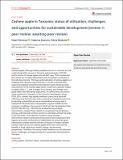| dc.description.abstract | Home Browse Cashew apple in Tanzania: status of utilization, challenges, and opportunities...
ALL METRICS
143
VIEWS
14
DOWNLOADS
Get PDF
Get XML
Cite
Export
Track
Share
▬
POLICY BRIEF
Cashew apple in Tanzania: status of utilization, challenges, and opportunities for sustainable development [version 1; peer review: awaiting peer review]
Noel Dimoso https://orcid.org/0000-0002-5536-3437, Neema Kassim, Edna Makule https://orcid.org/0000-0003-3077-8932
Author details
This article is included in the Agriculture, Food and Nutrition gateway.
Abstract
Cashew apples, although widely available and rich in nutrients are still underutilized after harvest in Tanzania. Approximately 2,327,000 metric tonnes of cashew apples are lost each year. Their counterpart, the cashew nut is highly appreciated and successfully contributes to the national economy. The huge underutilization of cashew apples is a challenge that requires urgent attention in order to achieve both national and global Sustainable Development Goals (SDGs) by 2030. Improvement of the cashew apple sector could have a positive impact on global SDGs 1, 2, and 3 targets of no poverty, zero hunger, and good health and well-being respectively. At national level, this sector could contribute to the goals of the Tanzania Development Vision (TDV) 2025, namely: high quality livelihood, particularly food self-sufficiency and food security; and a strong and competitive economy, particularly a diversified and semi-industrialized economy with a substantial industrial sector comparable to typical middle-income countries. In addition, the country’s Third Five Year Development Plan III (FYDP III) 2021/22 – 2025/26 has established key strategic interventions, notably those related to competitive industrialization, energy, and food and nutrition security to ultimately achieve the goals of the TDV 2025. To be effective, however, these strategic interventions require continued strong central and local government support and active involvement of stakeholders to ensure program effectiveness yielded towards efficient utilization of widely available natural resources such as cashew apples which has cross-cutting benefits in food, agriculture, health, energy, and economic perspectives. Therefore, the work provides evidence on the utilization status, challenges, and opportunities for sustainable development in Tanzania. | en_US |

